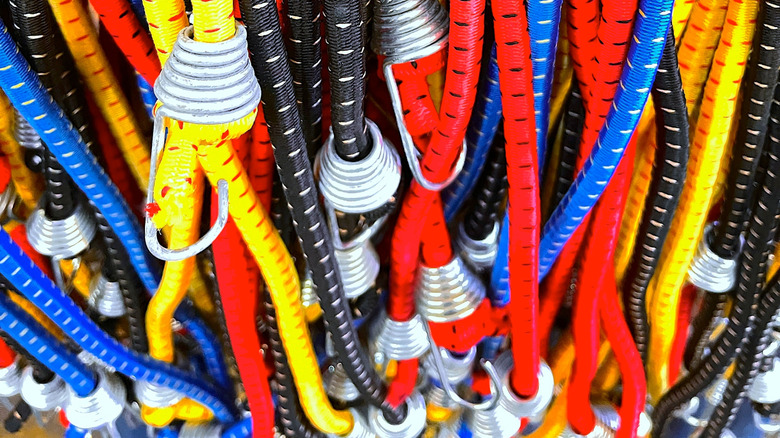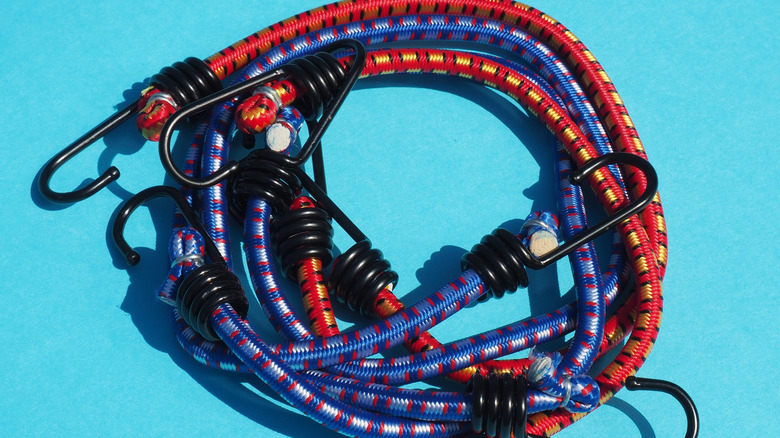Downsides Of Bungee Cords You Should Know Before Using Them In Home Improvement
Anyone who has used a bungee cord knows it can be a real workhorse. Whether you're securing something to a car roof, tethering tents while camping, or organizing your garage tools, they are a multi-faceted household doer. They're not needed every day, but when they are, few other things can do the job.
Bungee cords are different from other fasteners. With a rubber core covered with polypropylene or polyethylene, they are strong, stretchy, lightweight, and flexible, allowing for adjustable tension and the ability to hold a good amount of weight. And that's not to mention, they are also shock-absorbent and come in various colors, lengths, and thicknesses, with hooks or without.
But despite their many uses around the home, garden, and beyond, bungee cords come with some drawbacks to consider. No matter how mighty they are, their load capacity is limited compared to other fasteners. And Improper use and unexpected release can cause serious injury. So make sure you know how to combat the downsides before pulling them out.
Load capacity for bungee cords versus other fasteners
How much weight can a bungee cord safely hold? It depends on the thickness you're using. The little guys hold less, of course. For example, a 1/8-inch-diameter cord will secure 8 to 20 pounds, while a 5/8-inch-diameter cord is good for 40 to 100 pounds. However, the breaking strength — the point at which the cord will snap when subjected to a sudden force — is also a consideration, so you'll want to make sure your load will not cause a force greater than this. Both pieces of information should be included on the manufacturer's packaging.
If your needs exceed the capacity of a bungee cord, one alternative is a ratchet strap, which is a thicker polyester strap. These can be used to more tightly secure a load and can also secure more weight. For comparison, a 1-inch ratchet strap has a weight capacity limit of about 1,000 pounds, while a 2-inch strap has a weight load limit of up to 3,333 pounds.
Rope is another stronger alternative that also boasts the flexibility of a bungee cord. Depending on the material you choose, a 1/8-inch-diameter rope can have a weight load limit of anywhere from 26 to 600 pounds, while a 5/8-inch rope can accommodate from about 700 to 9,600 pounds. Plus, rope is easy to knot and cut to your desired length.
Tips for properly using bungee cords
Using bungee cords safely and effectively just requires a little education. The industry requires them to come with warning labels, but if you're like most people and never look at those, here's what you should know.
Know how to take care of your bungee cords. Always inspect your cord before use; if you see any fraying or damage, do not use it. Never stretch the cord by more than 50% because it can cause the cord or hook to fail. And always stretch it sideways rather than toward or away from yourself to avoid being in the recoil path should the cord unexpectedly contract. Wearing protective eyewear around bungee cords is also recommended, just in case. Finally, bungee cords should not be used to secure flat items that can move when exposed to wind.
Cord too long for the job? Don't tie knots to shorten it. That creates added stress and wear and tear because the knotted portion doesn't hold as much energy or tension, causing the ends to stretch further. Instead, try using a different hooking point. Hooking together more than two straps is also a no-no. The hooks are the most feeble part of a bungee cord, and they don't stretch, so the cords often have to be pulled tighter to take up any slack. That is a safety hazard and adds to quicker deterioration. Use a longer bungee cord for additional inches.


